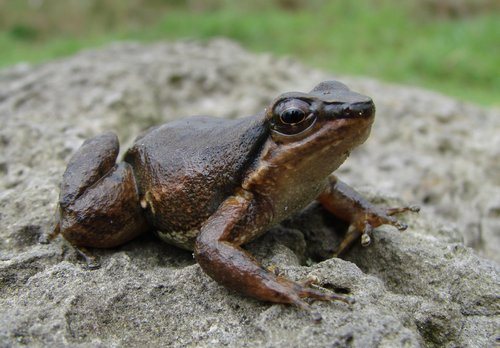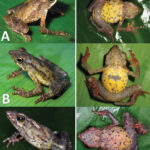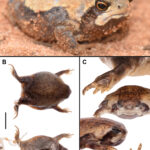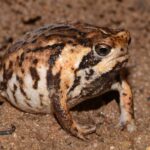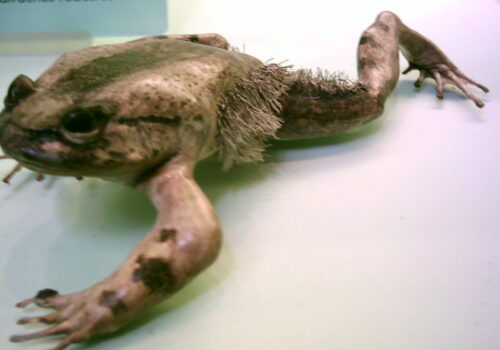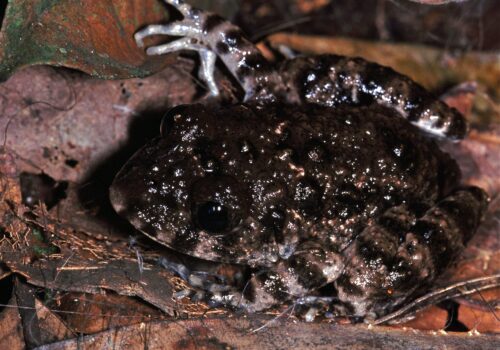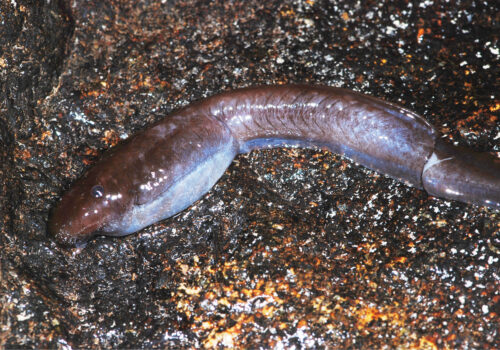Exploring Rheobates palmatus: Colombia’s Enigmatic Palm Rocket Frog#
Hidden beneath lush forest canopies and nestled beside shimmering mountain streams in the Colombian Andes lives a small, unassuming amphibian known as the Palm Rocket Frog (Rheobates palmatus). It is neither brightly colored nor famous from popular nature documentaries, yet it quietly commands a corner of the ecosystem, uniquely adapted to its niche and playing a critical, often overlooked role in maintaining biodiversity.
Named for the subtle webbing between its toes—hinting at a specialized aquatic lifestyle—the Palm Rocket Frog invites curiosity when one peers closer into its complex behaviors and adaptive strategies. In a region of spectacular biodiversity, home to hundreds of unique amphibian species, what makes Rheobates palmatus stand apart? Let’s immerse ourselves in the compelling story of this enigmatic frog and the delicate threads connecting it to the ecosystems it inhabits.
Taxonomy and Classification#
The Palm Rocket Frog belongs to the family Aromobatidae, a diverse group of small, ground-dwelling frogs famed for their secretive lifestyles and subtle yet fascinating adaptations. Within Aromobatidae, Rheobates palmatus is classified under the genus Rheobates, derived from Greek roots meaning “stream walker,” indicative of its intimate relationship with freshwater environments.
First described in scientific literature in 1925, this species has become the center of interest among herpetologists looking to unravel subtle ecological adaptations to Colombia’s unique forests and streams. Its remarkably specialized morphology and behaviors primarily set it apart from its closest evolutionary relatives, highlighting an example of adaptation to very specific local environmental conditions.
Natural Habitat#
The Colombian Andes: A Paradise of Biodiversity#
Rheobates palmatus is found exclusively within the lush, emerald corridors of Colombia’s Andes mountain range, favoring humid lowland and foothill forests between approximately 500 and 2,100 meters above sea level. These dense montane and submontane forests showcase a mosaic of ecosystems, from misty cloud forests to clear, mountain-fed streams. Within these verdant worlds, the Palm Rocket Frog thrives primarily along streams and damp forest floors, where moisture constantly nourishes the diverse flora and fauna.
The strongest concentration of populations occurs within Colombia’s Magdalena River basin in the departments of Cundinamarca, Santander, Boyacá, Antioquia, and Caldas, highlighting its preference for habitats with deeply shaded, rocky, and leaf-littered surfaces along gently flowing waters. Here, in this damp and cool microhabitat, the frog finds refuge beneath logs, stones, or crevices—places offering optimal humidity and protection from predators and weather extremes.
Physical Characteristics#
Subdued Beauty and Subtle Adaptations#
At first glance, the Palm Rocket Frog doesn’t dazzle observers with bold, warning colorations. Instead, its charm lies within subtlety—earth-toned, cryptic colorations designed meticulously by evolution for camouflage within the leaf-littered forest floor. Typically ranging from 20 to 30 millimeters in length, this diminutive frog possesses a slender yet robust body, adapted perfectly to moving swiftly across slippery stones and foliage.
A notable defining characteristic—hence the name “palmatus”—is the presence of partially webbed feet. The “rocket” aspect of its name arises from its swift and agile jumps, swiftly propelling it away from potential threats. Its skin has a slightly rough texture yet retains moisture efficiently, critical to its survival in habitats where humidity fluctuates quickly.
Moreover, its cryptic coloration—typically patterns of mottled brown, tan, olive, and gray—grants effective camouflage against the forest substrate, providing vital protection from visual predators. Forward-pointing eyes grant the Palm Rocket Frog remarkable binocular vision, essential for navigating its densely forested, rocky terrain in low light.
Behavior and Life Cycle#
An Intricate Dance of Survival and Courtship#
Despite its modest appearances, the behavioral ecology of Rheobates palmatus offers fascinating insights into amphibian adaptations. As insectivorous predators, Palm Rocket Frogs actively forage among the leaf litter and along rocky surfaces near streams, capturing small insect prey such as ants, beetles, flies, and larvae swiftly using their adept tongues honed by evolutionary advantage.
Their life cycle follows a classic amphibian metamorphosis trajectory, yet exhibits unique behavioral adaptations. During Colombia’s rainy and humid seasons, temperatures stabilize, humidity peaks, and males set the stage for a fascinating courtship spectacle. A male Palm Rocket Frog claims a prime location along suitable streams or shallow pools, emitting a surprisingly resonant call—a rhythmic series of clicking or chirping notes. This melody serves a dual purpose: attracting females ready to lay eggs and simultaneously warding off rival males.
Females utilize finely tuned auditory senses to locate potential partners, guided toward males’ carefully selected egg-laying sites. In a fascinating display of parental investment, males vigilantly guard egg clutches, ensuring they remain suitably moist and protected from potential threats, including predators and fungal infections.
Tadpole Development in Crystal-Clear Streams#
Once hatched, tadpoles exhibit highly specialized morphologies adapted to swift streams’ challenges—possessing muscular, streamlined bodies and reinforced oral discs that unlock algae from rocks, scraping biofilms with impressive efficiency. Development from tadpole to adult frog is rapid, influenced heavily by water temperature, prey availability, and predation pressures, typically culminating in a few short weeks to months, depending on environmental conditions.
Ecological Role#
Invisible Links in the Chain of Life#
Like many small amphibians, the Palm Rocket Frog plays critical ecological roles, acting as both predator and prey, thereby linking various forest food web components. Their voracious appetite for insects helps maintain balanced insect populations, indirectly benefiting plant communities reliant on insect pollination and seed dispersal.
Moreover, as prey, they nourish numerous forest predators, including snakes, birds, and mammals. This delicate balancing act positions Rheobates palmatus as a key indicator species—its health mirrors the ecological well-being of Colombian montane forests and freshwater ecosystems.
Threats and Conservation Status#
Facing an Uncertain Future#
Despite their impressive adaptations, Palm Rocket Frogs face significant threats associated primarily with habitat destruction and degradation. Expansion of agriculture and cattle ranching, deforestation for timber and firewood, urbanization, and pollution increasingly fragment and degrade their natural habitats, isolating populations and limiting genetic flow necessary for long-term species survival.
Additionally, amphibian pathogens such as chytridiomycosis remain immediate threats, triggered partly by rapidly changing climates promoting pathogen spread into previously unaffected montane forests. The International Union for Conservation of Nature (IUCN) currently lists Rheobates palmatus as “Least Concern,” reflecting stable populations—yet conservationists vigilantly monitor evolving threats, recognizing the frog’s fragile balance within its sensitive environment.
Cultural and Scientific Significance#
Culturally understated, the Palm Rocket Frog nevertheless symbolizes Colombia’s delicate biodiversity and flourishing, intricate ecosystems requiring stewardship and scientific curiosity. It embodies the subtle yet essential roles smaller species hold in ecological health and biodiversity conservation.
Scientifically, studying Rheobates palmatus offers profound insights into amphibian physiology, ecosystems’ subtle interactions, and the unique adaptive paths evolution has carved for species inhabiting geographically isolated, richly diverse environments.
Conclusion#
In uncovering the intriguing world of Rheobates palmatus, we’ve glimpsed a fascinating creature perfectly adapted to its narrow yet rich ecological niche. The Palm Rocket Frog represents far more than its humble appearance suggests; its existence unravels the incredible intricacy of ecosystems where every species and microhabitat play crucial roles.
The ongoing conservation of Colombian forests and streams, habitat restoration initiatives, and scientific research projects all carry cultural and ecological value, preserving creatures such as Rheobates palmatus for future generations. We can all play a part in deepening our understanding, appreciation, and protection of such unsung heroes of biodiversity—a small frog urging us toward higher stewardship and wonderment of the natural world.

